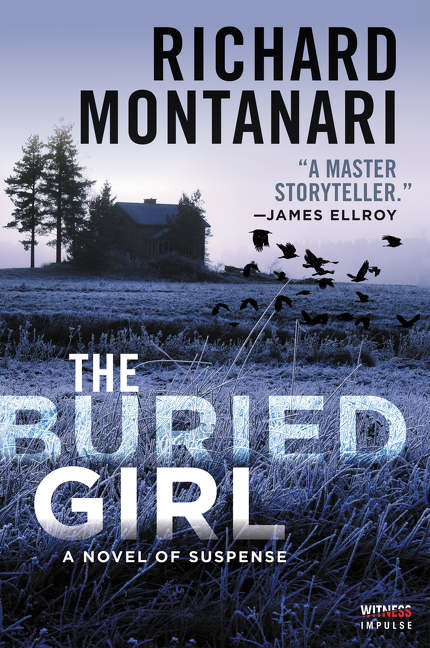The Buried Girl
by Richard Montanari
on Tour March 1-31, 2019
Synopsis:

A haunting, nerve-jangling psychological thriller from Sunday Times bestselling author Richard Montanari, set in a small town hiding a very dark secret
New York psychologist Will Hardy had it all—a loving family, a flourishing career, a bestselling book. Until the night it all ended in a tempest of fire and ash, leaving only Will and his fifteen-year-old daughter Bernadette to stand in the ruins.
Haunted and grief-stricken, Will accepts an enigmatic invitation from his family’s past to begin their lives anew in the small town of Abbeville, Ohio.
Meanwhile, Abbeville Chief of Police Ivy Holgrave is investigating the death of a local girl, convinced this may only be the latest in a long line of murders dating back decades—including her own long-missing sister.
But what place does Will's new home have in the story of the missing girls? And what links the killings to the diary of a young woman written over a century earlier? The disappearances in Abbeville have happened before, and now Will’s own daughter might be next…
Book Details:
Genre: Mystery
Published by: Witness Impulse
Publication Date: February 26th 2019
Number of Pages: 400
ISBN: 0062467468 (ISBN13: 9780062467461)
Read an excerpt:
Amsterdam
March 22, 1819
On the third day of his madness Dr Rinus van Laar tasted the mouth of the devil. He stepped from the ruin of his home, into the courtyard where the body of his wife, dead these three days, had begun to soften and pigment. He remembered the first time he had seen Anna that day by the river. Her skin was now the color of dry bones.
Anna’s killer lay scattered beside her in seven pieces. Six, Rinus amended. He could not remember where he had put the man’s head. He longed to look once more into those lifeless eyes.
He pulled the dropper from the amber bottle, let six drops of mandragora onto his tongue. He closed his eyes to the fury of the onslaught.
Some time later he carefully returned the drawings to the leather portfolio. Fourteen preliminary sketches by the master, already more than two centuries old.
Seven vices. Seven virtues.
It was this treasure the killer sought. It was in defense of this treasure that Anna had given her life.
He placed the portfolio into the steamer trunk, latched it, secured the iron lock. As he prepared to leave he considered the aviary snare. The white bird studied him, its silver eyes watching, waiting, a thin leather strap tightly coiled around one leg.
Rinus van Laar looked one last time at his wife, and saw the tiny tendril; a bright green leaf against the matte claret of Anna’s drying blood.
In her virtue there was life.
Six hours later, his infant son in his arms, Rinus van Laar left for America.
***
BEING THE TRUE DIARY AND JOURNAL OF EVA CLAIRE LARSSEN
October 21 1868
We left Midlothian before dawn. I am riding back wagon with Deirdre Samuelsson and her brother Jonah. Jonah is still small, and thinks of all this as an adventure. Deirdre is my age, just fourteen, and terribly shy due to her stammer.
They say six hundred thousand died in the war. Imagine. Daddy was killed at Manassas. Mama also died from Yankee hellfire, but not right away. Not Sonja Larssen. She held ground three years, and breathed her last yesterday at noon. Our first day’s journey took us seven miles.
The dead walk behind us.
November 9, 1868
The rain is endless. We got stuck twice on the road out of Rowleton, where we picked up two weeks domestic work. Mr. Samuelsson had to ask some local boys and their mules to help pull the wagon from the culvert. My sweater got soaking wet, and as the wool dried by the fire last night it smelled of Mama. I cried myself to sleep again.
April 9, 1869
We crossed the Ohio River at Wheeling this morning. Deidre and I went to the general store and bought nails and tobacco for Mr. Samuelsson. He let us buy some fruit, and I had the most delicious pear.
Ohio looks like home before the war.
April 16, 1869
I awoke to the sound of church bells. When I climbed down from the wagon I saw that we were stopped on the crest of a hill overlooking the most beautiful valley I have ever seen.
When I stepped to the edge I saw them for the first time. Two grand houses facing each other across a field of green, houses so important they even have names. Veldhoeve and Godwin Hall. I will be working at one, and staying in the other.
Imagine.
April 24, 1869
All the buildings here are freshly painted and well cared for. The war did not come to this place. When we reached the town square I looked at the plaque.
Abbeville, Ohio. Est. 1790
Sitting on top of the plaque was a beautiful white bird, its pearl feathers glossed with early morning rain. I sat on the bench across from it and took out my pencils and pad. This is my drawing.
Although I am not taken by such notions, as I left the square, I could swear that bird was watching me.
Tomorrow morning I will begin work at Godwin Hall. If you are reading this, if the sun now shines where you stand, it means I am long forgotten.
If you are reading this, it means I never made it back home again.
***
Excerpt from The Buried Girl by Richard Montanari. Copyright © 2019 by Richard Montanari. Reproduced with permission from Witness Impulse. All rights reserved.
March 22, 1819
On the third day of his madness Dr Rinus van Laar tasted the mouth of the devil. He stepped from the ruin of his home, into the courtyard where the body of his wife, dead these three days, had begun to soften and pigment. He remembered the first time he had seen Anna that day by the river. Her skin was now the color of dry bones.
Anna’s killer lay scattered beside her in seven pieces. Six, Rinus amended. He could not remember where he had put the man’s head. He longed to look once more into those lifeless eyes.
He pulled the dropper from the amber bottle, let six drops of mandragora onto his tongue. He closed his eyes to the fury of the onslaught.
Some time later he carefully returned the drawings to the leather portfolio. Fourteen preliminary sketches by the master, already more than two centuries old.
Seven vices. Seven virtues.
It was this treasure the killer sought. It was in defense of this treasure that Anna had given her life.
He placed the portfolio into the steamer trunk, latched it, secured the iron lock. As he prepared to leave he considered the aviary snare. The white bird studied him, its silver eyes watching, waiting, a thin leather strap tightly coiled around one leg.
Rinus van Laar looked one last time at his wife, and saw the tiny tendril; a bright green leaf against the matte claret of Anna’s drying blood.
In her virtue there was life.
Six hours later, his infant son in his arms, Rinus van Laar left for America.
***
BEING THE TRUE DIARY AND JOURNAL OF EVA CLAIRE LARSSEN
October 21 1868
We left Midlothian before dawn. I am riding back wagon with Deirdre Samuelsson and her brother Jonah. Jonah is still small, and thinks of all this as an adventure. Deirdre is my age, just fourteen, and terribly shy due to her stammer.
They say six hundred thousand died in the war. Imagine. Daddy was killed at Manassas. Mama also died from Yankee hellfire, but not right away. Not Sonja Larssen. She held ground three years, and breathed her last yesterday at noon. Our first day’s journey took us seven miles.
The dead walk behind us.
November 9, 1868
The rain is endless. We got stuck twice on the road out of Rowleton, where we picked up two weeks domestic work. Mr. Samuelsson had to ask some local boys and their mules to help pull the wagon from the culvert. My sweater got soaking wet, and as the wool dried by the fire last night it smelled of Mama. I cried myself to sleep again.
April 9, 1869
We crossed the Ohio River at Wheeling this morning. Deidre and I went to the general store and bought nails and tobacco for Mr. Samuelsson. He let us buy some fruit, and I had the most delicious pear.
Ohio looks like home before the war.
April 16, 1869
I awoke to the sound of church bells. When I climbed down from the wagon I saw that we were stopped on the crest of a hill overlooking the most beautiful valley I have ever seen.
When I stepped to the edge I saw them for the first time. Two grand houses facing each other across a field of green, houses so important they even have names. Veldhoeve and Godwin Hall. I will be working at one, and staying in the other.
Imagine.
April 24, 1869
All the buildings here are freshly painted and well cared for. The war did not come to this place. When we reached the town square I looked at the plaque.
Abbeville, Ohio. Est. 1790
Sitting on top of the plaque was a beautiful white bird, its pearl feathers glossed with early morning rain. I sat on the bench across from it and took out my pencils and pad. This is my drawing.
Although I am not taken by such notions, as I left the square, I could swear that bird was watching me.
Tomorrow morning I will begin work at Godwin Hall. If you are reading this, if the sun now shines where you stand, it means I am long forgotten.
If you are reading this, it means I never made it back home again.
***
Excerpt from The Buried Girl by Richard Montanari. Copyright © 2019 by Richard Montanari. Reproduced with permission from Witness Impulse. All rights reserved.
Author Bio:
RICHARD MONTANARI is the Sunday Times top ten bestselling author of The Echo Man, The Devil’s Garden, Play Dead, The Rosary Girls, The Skin Gods and Broken Angels, as well as the internationally acclaimed thrillers Kiss of Evil, Don’t Look Now (previously published as Deviant Way) and The Violet Hour. He lives in Cleveland, Ohio.
Catch Up With Our Richard On:
Website, Goodreads, BookBub, Twitter, & Facebook!
Tour Participants:
Visit these other great hosts on this tour for more great reviews, interviews, guest posts, and giveaways!


This sounds like a thrilling read!
ReplyDelete